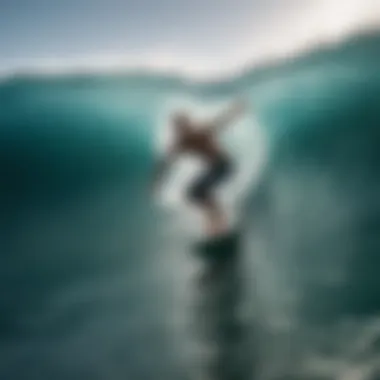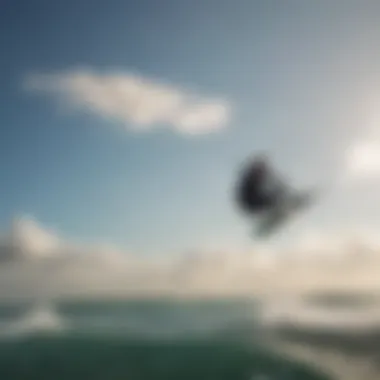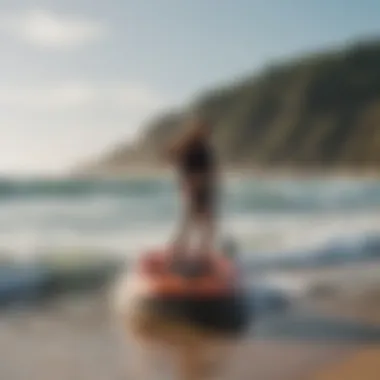Exploring the Depths of Watersports: An Overview


Intro
Engaging in watersports goes beyond splash and play; it's a deep dive into a culture rich with history and community. Whether you're gliding on waves while surfing, catching the calm of lakes on a paddleboard, or harnessing the wind's power with kitesurfing, each of these activities offers not just thrill but a connection to nature and self.
These sports are more than mere pastimes. For many, they are ways of life, embodying freedom, adventure, and a quest for personal growth. The journey into the world of watersports invites participants to learn about the equipment, perfect their techniques, and embrace the crucial principles of safety that keep the enjoyment alive. Cultural significance threads through as well, as these activities often cultivate communities that share values of respect for the environment and camaraderie.
In this comprehensive overview, readers will explore gear essentials tailored for each discipline, offering insights into what to buy, how to maintain it, and the critical safety measures necessary for an enjoyable experience. Alongside this, techniques for both beginners and seasoned pros will be discussed, focusing on how efficiency and skill can not only enhance performance but enrich the overall experience. By the end of this narrative, you'll have a strong grasp of the ins and outs of watersports, poised to catch the next wave, paddle out on a serene lake, or take fly on the wind.
Understanding the Watersport Culture
The realm of watersports is not merely a collection of activities; it is deeply woven into the fabric of modern culture. By delving into the watersport culture, one uncovers a community that spans across continents and connects individuals through shared passions and experiences. This section aims to highlight the intrinsic aspects of why understanding this culture is vital, especially for enthusiasts and newcomers alike.
Historical Context of Watersports
To grasp the significance of watersports today, one must reflect on their historical roots. For instance, many modern surfing techniques can be traced back to ancient Polynesian cultures, where surfing was not just a sport but a spiritual experience. The thrill of riding waves on wooden boards carries a legacy that informs current practices. Paddleboarding, too, has a lineage; initially used as a method of transportation and fishing in various indigenous communities, it has transformed into a sport enjoyed worldwide.
In light of these historical contexts, we see that watersports have always played a role in community cohesion and cultural expression. These activities often reflect societal values, revealing how communities interact with their natural surroundings. Watersports are far from just physical pursuits; they are layered experiences rich in tradition and meaning.
Global Influence of Water Nexus
The influence of the water nexus—this interconnection of oceans, rivers, and lakes—extends beyond mere recreation. It embodies livelihoods and lifestyles, particularly in coastal regions where watersports thrive. The global impact is significant: from small fishing villages that have now turned into kitesurfing hotspots like Tarifa in Spain, to the vibrant surf culture of Huntington Beach in California.
Moreover, the water nexus serves as a binding force, drawing together different cultures. At surf competitions or paddleboarding events, individuals from various backgrounds come together, celebrating their shared love of the water. Not only do such gatherings foster friendships, they also promote an exchange of ideas and practices that can innovate the experiences within each sport.
In addition to promoting cultural exchange, understanding the global influence of watersports helps in recognizing their importance in environmental conservation. As practitioners become more aware of the ecological issues facing oceans and waterways, there is a growing emphasis on sustainability. This intersection of culture and environmental stewardship creates a community that is passionate about preserving the natural beauty they seek to enjoy.
By examining the threads that bind watersports to culture and community, enthusiasts can better appreciate not just the skills required for these activities, but their broader implications. Each wave ridden, or paddle stroke taken, echoes a history steeped in both local tradition and global connectivity.
"Watersports are not just about the ride; they are a conduit for culture, history, and community."
Understanding the watersport culture enables practitioners to engage more deeply with their sport, fostering a sense of belonging that enhances their experiences. With the backdrop of history and global connection influencing their passion, watersport enthusiasts can navigate their journeys with authenticity and purpose.
Surfing: The Quintessential Watersport
Surfing represents more than just a sport; it embodies a lifestyle deeply rooted in culture, freedom, and the ocean's majesty. As we navigate through this article, embracing the waves of knowledge, we can glean a wealth of insights pertinent to aficionados and newcomers alike. At its heart, surfing fosters a connection with nature while offering exhilaration and mental clarity. Understanding the nuances of this aquatic activity paves the way for appreciating its significance within the broader watersport domain.
The Evolution of Surfing
Surfing has a rich and storied history, often traced back to ancient Polynesian culture. Evidence suggests that as far back as 1000 AD, individuals in Hawaii were gliding across waves on wooden boards. These early surfers didn't merely ride for enjoyment but engaged in a spiritual connection with the ocean, intertwining surf culture with rituals and beliefs.
As time marched on, surfing saw its rebirth in the early 20th century with figures like Duke Kahanamoku bringing the sport to the masses. The post-war surf scene burgeoned, especially in California, where surf culture flourished amidst changing social fabrics. From the wild, carefree days of surfboards made from local woods to today’s high-performance fiberglass models, the evolution reflects not just technology but also the lifestyle shifts within its community.
Surfboard Design Innovations
When talking about surfing, the surfboard itself takes center stage, and its design has transformed dramatically over the decades. Earlier boards were hefty and crafted from solid woods, requiring great skill to maneuver. Fast forward to today, and you’ve got a mesmerizing spectrum of shapes and materials.
- Material Diversity: Modern surfboards are primarily made from polyurethane foam or epoxy resin, balancing durability and weight. Carbon fiber is also making waves for providing strength without excess weight.
- Shape Variations: You’ve got shortboards for high-speed maneuvers, longboards for smooth cruising, and fish tail boards for those punchy shorter waves. Each design serves a distinct purpose, enhancing the experience based on surf conditions.
"The board is an extension of the surfer's body; it must resonate with how they ride the waves."
These innovations stem from not just technological advancements but from surfers' feedback, reflecting their needs within varying wave conditions. Whether racing through hollow barrels or catching small summer swells, the right board can make all the difference.
Key Surf Destinations Around the World
When you think of surfing, images of azure waves and golden sands likely dance in your minds' eye. Various destinations around the globe have established themselves as hallowed ground for surfers.
- Hawaii: Often deemed the birthplace of surfing, places like Waikiki and the infamous North Shore boast legendary waves.
- Australia: The Gold Coast exemplifies the surf culture, featuring world-class breaks like Snapper Rocks.
- California: Iconic spots such as Malibu and Huntington Beach showcase diverse conditions for all surfing levels.
- Bali, Indonesia: A surfer's paradise, known for its consistent waves and vibrant surf community.


Each location offers unique characteristics, attracting surfers of all skill levels. A trip to these places not only enhances one's skills but also deepens the appreciation for the global surf culture, where camaraderie thrives among individuals from varying backgrounds all chasing similar thrills in the ocean.
Surfing, as we’ve explored, is a compelling blend of history, innovation, and community. Each aspect reinforces its role as a quintessential watersport, inviting enthusiasts to partake in the exhilarating chaos the ocean provides.
Paddleboarding: A Comprehensive Guide
Paddleboarding has gained significant traction over the past decade. This thrilling water activity isn't just about gliding on calm waters; it offers an opportunity for fitness, relaxation, and adventure all rolled into one. Whether you're a beginner, a fitness junkie, or someone looking to chill on the water, paddleboarding provides a versatile experience that can cater to various interests. This section dives into the different types of paddleboards, essential techniques for novices, and some of the best locations to paddleboard around the globe.
Types of Paddleboards
Understanding the variety of paddleboards available is crucial for anyone entering the sport. The right board can make all the difference. Here’s a breakdown of some common types to consider:
- All-Around Boards: Ideal for beginners, these boards offer a stable platform to accommodate various water conditions. Great for exploring lakes or slow rivers.
- Touring Boards: Longer and narrower, these boards are designed for speed and efficiency on longer paddling trips. They excel on open water and multi-day adventures.
- Racing Boards: If competition is your thing, these are for you. They are even longer and lighter, optimized for maximum speed.
- Yoga Boards: With a wider and more stable surface, these are perfect for practicing yoga on the water, combining fitness with serene surroundings.
Each type serves a different purpose and function, making it vital to choose wisely depending on your intended use and skill level.
Techniques for Beginners
Getting started with paddleboarding may seem daunting, but it’s simpler than one might think. Here are some fundamental techniques to ensure a smooth start:
- Posture: Stand with feet parallel and shoulder-width apart, knees slightly bent. Having your body aligned is essential for balance.
- Paddling Technique: Use long strokes that reach forward, pulling the paddle through the water, and use the core for strength, not just the arms.
- Turning: To turn, paddle on one side more than the other. For sharper turns, use a reverse stroke with the paddle.
- Stopping: To halt, position the paddle perpendicular to the board. This acts as a brake, slowing down your momentum.
"Practice makes perfect. Don’t be discouraged if you wobble a bit; balance comes with time."
Popular Paddleboarding Locations
Once you’ve got the basics down, it’s time to explore where to paddle. There are countless stunning locations suitable for both scenic beauty and varying levels of challenge:
- Lake Tahoe, California/Nevada: Known for its crystal-clear water, this lake offers spectacular views and perfect conditions for all skill levels.
- Bondi Beach, Australia: A hot spot for surfers, paddleboarders can enjoy beautiful waves while soaking up the sun.
- The Florida Keys, USA: With numerous serene mangroves and crystal-clear waters, it's a great spot for wildlife watching.
- Bora Bora, French Polynesia: Famous for its turquoise lagoons, paddleboarding here feels like you’re on vacation all year round.
Regardless of where you choose to paddle, safety should always come first. Being aware of local conditions, wildlife, and adhering to regulations ensures that your paddleboarding experience remains enjoyable and safe.
In summary, paddleboarding opens up a world of possibilities for outdoor enthusiasts. By understanding the types of boards, mastering essential techniques, and knowing where to paddle, you can fully embrace the joy and tranquility that this watersport offers.
Kitesurfing: Navigating the Winds
Kitesurfing has carved its niche in the watersports realm, blending elements of surfing, windsurfing, and paragliding. Its appeal lies not only in the adrenaline rush but also in the unique connection between the rider and the elements. When you slice through the waves, harnessing both wind and water, there’s a profound sense of freedom. This section delves into the essentials needed to become proficient at this exhilarating sport, as well as key considerations for both safety and the selection of prime kitesurfing locations.
Essential Kitesurfing Equipment
To kick things off, let's get a handle on the fundamental gear needed. The right equipment can make or break your kitesurfing experience. Here’s what you really need:
- Kite: The heart of the sport. Choices range from inflatable kites that provide buoyancy and stability to those meant for high air performance.
- Control Bar and Lines: This is your steering system, allowing you to maneuver the kite effectively. A quality control bar gives you a sense of control while handling gusts and lulls.
- Board: There are a number of options here, including twin-tips for freestyle or directional boards for surfing style. Your choice impacts your performance on different types of waves and wind conditions.
- Harness: A good harness distributes the power of the kite evenly across your body. This frees your hands to steer and keeps you more comfortable.
- Impact Vest and Helmet: While not mandatory, vests and helmets can save you from serious injuries. They help keep you safe during wipeouts and other unexpected situations.
Choosing the right size kite and board for your body weight and skill level is crucial. Kites come in various sizes, typically ranging from 5 to 18 square meters. The ideal one often depends on wind speeds and your personal preference.
Safety Measures and Protocols
Every thrilling sport comes with its share of risks. Kitesurfing is no exception. Knowing how to mitigate those risks can save your day, or perhaps even your life. Here are some essential safety measures:
- Know Your Surroundings: Always check weather conditions and tides before hitting the water. Wind direction and speed can change in a heartbeat, so be alert.
- Pre-Flight Checks: Always inspect your gear to ensure everything is in working condition. Check your lines for frays and the kite for holes before launching.
- Practice Emergency Procedures: Familiarize yourself with how to react if you get into trouble. Learning how to perform a self-rescue can be invaluable.
- Stay Away from Obstacles: Whether it's rocks, people, or boats, avoiding such hazards can keep you and others safe.
- Buddy System: Kitesurfing is often safer and more enjoyable with a partner. Always have someone else around who can assist or call for help if needed.
Adhering to these protocols not only protects you but also promotes a culture of safety within the community.
The Best Kitesurfing Spots
The best kitesurfing spots are a dream come true for enthusiasts, with ideal wind and water conditions drawing kitesurfers from around the globe. Here are a few top locations:
- Cabo Verde, Cape Verde: Known for its steady winds and warm water, this destination is often revered as kitesurfing paradise.
- Tarifa, Spain: With its reputation as Europe’s wind capital, Tarifa offers great conditions year-round.
- Maui, Hawaii: The dynamic conditions attract seasoned pros and newbies alike. The beauty of the waves here is hard to beat.
- Speak Island, Denmark: This hidden gem boasts reliable wind and is less crowded, ideal for those looking for a more laid-back experience.
- Langebaan, South Africa: Perfect for beginners and pros, this location features flat waters and consistent winds.


"Explore those locations with a sense of adventure, but do respect their local rules and environments as well."
Gear and Equipment Recommendations
When it comes to watersports, having the right gear is like having the right shoes for a marathon. The equipment you choose not only affects your performance, but can also play a crucial role in your safety and comfort on the water. Each sport—whether it's surfing, paddleboarding, or kitesurfing—has specific needs that demand careful consideration.
Choosing the Right Gear for Your Sport
Selecting gear that suits your style and skill level is critical. What works for a seasoned surfer might not be suitable for a beginner just dipping their toes into the sport.
Surfing Gear Considerations:
- Surfboards: The size, shape, and material of your board can drastically impact your surfing experience. For instance, a longboard provides stability for novices, while a shortboard offers agility for advanced surfers.
- Wetsuits: These come in various thicknesses, which affect warmth. A thicker wetsuit is useful in colder climates, but can hinder flexibility.
Paddleboarding Gear:
- Board Type: Not all paddleboards are created equal. All-around boards are great for beginners. Focusing on specific types like racing or yoga boards depends on your intended use.
- Paddles: Consider the length and material of your paddle. A lighter paddle is less strenuous in long paddling sessions.
Kitesurfing Gear:
- Kite Size: The right kite size can influence how well you catch the wind. Larger kites are suitable for lighter winds, while smaller kites are better for strong winds.
- Harnesses: Comfort is key here. A well-fitted harness prevents fatigue and improves control over your kite.
When you’re ready to purchase equipment, visit local shops or event expos. There, you can physically test items and ask suited experts for their opinions.
Maintenance and Care for Equipment
Once you’ve made an investment in your gear, maintaining it is paramount. Neglecting upkeep may lead not just to lower performance but also to accidents. Here are some fundamental maintenance tips for each type of watersport gear:
Surfboard:
- Rinse After Use: Always rinse your surfboard after a session to remove salt and sand. This prevents erosion and improves longevity.
- Repairs: Keep a repair kit handy for minor dings. Quick fixes save you from bigger problems down the line.
Paddleboard:
- Storage: Ensure your board is stored in a cool, dry place, away from direct sunlight. This prevents materials from warping.
- Inflatable Care: If you have an inflatable board, deflate it before storage to maximize lifespan.
Kitesurfing:
- Kite Care: Rinse your kite after each use and let it dry completely before storing. Sand in the seams can lead to tears.
- Lines and Harness Checks: Regularly inspect your lines for frays and your harness for wear. Safety first should always be the motto.
Every watersport enthusiast knows, regular maintenance can double the life of your gear. Investing time in care will result in fewer replacements and more exhilarating days on the water.
Staying informed and proactive about gear selection and upkeep encourages not just safety but also enhances the overall watersport experience.
Safety and Environmental Considerations
The world of watersports is not just about exhilaration and adventure but also deeply intertwined with safety and environmental awareness. Understanding these elements is crucial for every enthusiast because the thrill of riding the waves or gliding across the water can quickly turn into a perilous situation if caution is not exercised.
Understanding Ocean Conditions
Knowledge of ocean conditions is fundamental for anyone engaging in watersports. The dynamic nature of the sea can dictate your experience, dictating everything from the best times to hit the waves to the gear you might need. Several factors play into this:
- Tides: The rise and fall of sea levels can impact wave conditions significantly. Typically, surfers prefer to go out at mid-tide, when waves are often at their best.
- Winds: Wind direction and speed can create choppy waters or lead to potential hazards, especially in activities like kitesurfing. A strong offshore wind, for instance, can blow you out to sea rather quickly.
- Weather: Conditions such as storms or changes in weather patterns should never be taken lightly. It can turn a smooth day at the beach into a risky situation in minutes.
Before heading out, it’s vital for individuals to check local forecasts and advisories. Many just grab their gear and head out, but that can be like stepping into a ring without knowing who your opponent is. Local knowledge, whether from seasoned surfers or community groups, can also provide insights into the water’s temperament, ensuring a safe and enjoyable experience.
Eco-Friendly Practices in Watersports


As the popularity of watersports surges, so does the need to protect our oceans and waterways. Practicing eco-friendly measures not only preserves the marine ecosystem but also ensures that future generations can enjoy the same fun we do today.
Some practices include:
- Leave No Trace: Always clean up after yourself. Trash can harm wildlife and spoil beautiful locations. Bring a bag to collect your trash and any that's not yours.
- Choose Sustainable Gear: Equipment made from environmentally friendly materials can significantly reduce your ecological impact. Many brands are now focusing on sustainability in their production processes.
- Respect Wildlife: Disturbing animals or their habitats is a big no-no. Keeping a respectful distance is not just about human safety; it’s also about maintaining the natural order.
- Educate Others: Sharing information about the importance of conservation can multiply your impact. Whether it’s at a local surf camp or a kitesurfing event, make it a point to spread the word about protecting our waters.
"In every drop of water, there is a story of life." – Leena Patel
By embracing these practices, watersport enthusiasts can actively contribute to the stewardship of their beloved environments. The ocean gives us so much; it’s only fair that we give back. Understanding the conditions of our waters and practicing sustainability ensures the beauty of our oceans will persist, showing future generations the wonders they hold.
Community and Networking in Watersports
The world of watersports isn't just about the thrill of riding the waves or paddling through calm waters; it's deeply intertwined with the communities that form around these activities. The social fabric of watersports plays a crucial role in nurturing new talent, sharing knowledge, and promoting sustainability. As enthusiasts come together, they exchange tips, experiences, and stories that enrich everyone's understanding of the sport. Building strong networks can lead to improved skills, expanded horizons, and an overall deeper appreciation of water-based activities.
The Role of Local Communities
Local communities serve as the heartbeat of watersports culture. Each coastal town, lake, or riverbank has its own unique character, shaped by the people who frequent it. From surf schools like the famous Surf School Santa Barbara to paddleboarding clubs in Lake Tahoe, these local hotspots often come with dedicated groups fostering a sense of belonging among participants.
Local clubs often provide benefits such as:
- Skill Development: Beginners have the opportunity to learn from seasoned enthusiasts, gaining valuable insights.
- Events and Competitions: Local contests not only promote healthy competition but also serve as a means for locals to gather and celebrate their shared passion for watersports.
- Environmental Awareness: Many organizations launch initiatives aimed at preserving water bodies, showcasing how community efforts can lead to a healthier ecosystem.
Moreover, these communities can act as a support system where individuals can share challenges, successes, and even personal stories. The power of camaraderie can enhance one's experience, turning solitary pursuits into lively social gatherings.
Online Platforms for Watersport Enthusiasts
In today’s digital age, online platforms have revolutionized how watersport lovers connect. Websites, forums, and social media platforms create virtual havens where enthusiasts can share experiences, access learning resources, and form connections with like-minded individuals.
- Social Media Groups: Platforms like Facebook or Reddit offer group functionalities where members discuss topics ranging from gear advice to travel tips, making it a rich resource for both newbies and veterans.
- Forums and Blogs: These spaces act as archives of knowledge, where discussions on various watersports can lead to insightful revelations and practical how-to guides. Blogs by experts serve as great learning tools, filled with personal anecdotes that help demystify complex aspects of the sport.
- Video Channels: YouTube channels that focus on watersport reviews, tutorials, and experiences can be invaluable. Watching a video on how to manage challenging weather conditions, for example, becomes much easier when visualized.
By participating actively in these virtual communities, enthusiasts not only improve their skills but also stay abreast of the latest trends and gear. The online space, combined with local gatherings, creates a synergistic effect that elevates the watersport experience.
"Community is not just about sharing the same space by the water; it's about sharing the same passion for it."
Ultimately, fostering both local and online connections helps build a robust learning environment, enhancing the overall practice of surfing, paddleboarding, and kitesurfing. As watersport enthusiasts engage both on and offline, they're not just enjoying the thrill—they're contributing to a vibrant and sustainable future for the sports they love.
Future Trends in Watersports
Understanding the future trends in watersports is essential for enthusiasts keen on staying ahead of the curve. The landscape of watersports is continually changing, influenced by numerous factors ranging from technological leaps to environmental challenges. Such trends not only guide individual choice in activities or gear but also embrace a broader awareness of sustainability and community engagement.
Advancements in Technology and Gear
The evolution of technology plays a pivotal role in shaping how we engage with watersports. Innovations in materials and design have led to lighter, stronger gear that enhances performance while reducing environmental impact. For instance, many surfboards now utilize eco-friendly composites that diminish reliance on harmfu substances. Paddleboarding is no exception; boards are now often made from durable materials that decrease the chances of damage while in action.
Moreover, smart technology has introduced features that improve safety and performance. Wearable devices, such as waterproof smartwatches, provide real-time data on weather patterns, wave conditions, and water temperatures, enabling users to make informed decisions on when and where to ride.
Benefits of Technological Advancements:
- Improved Safety: Advanced gear with GPS tracking and emergency alerts.
- Enhanced Performance: Lighter materials mean better maneuverability.
- Sustainability: Eco-conscious products reduce environmental footprints.
The overall shift towards integrating technology with watersport activities not only makes them safer and more enjoyable but also cultivates a culture that is more in tune with the environment.
The Impact of Climate Change on Watersports
The effects of climate change are becoming increasingly apparent and have significant implications for the future of watersports. Rising sea levels, changing ocean currents, and increasing water temperatures are altering many of the locations where watersport enthusiasts gather. It’s not simply the coastlines being affected; even remote locations known for their portfolio of best conditions are seeing changes.
For instance, popular surf spots may experience shifts in wave patterns, as storms and warming waters change reefs and underwater topographies. Furthermore, paddleboarders must adapt to variations in river flow and water clarity. This unpredictability can lead to cancellations and cancellations really shake up communities built around watersport adventures.
"The water really is a reflection of what’s happening in our climate. Changes in weather patterns impact everything, from safety factors to where we can enjoy our passions."
It is vital for the watersport community to advocate for eco-friendly practices. Alongside enjoying these activities, a shared responsibility for the environment ensures that future generations can revel in the same waters we hold dear. Educating participants on sustainable habits can include:
- Practicing 'leave no trace' principles—clean up after yourself.
- Supporting local conservation efforts to protect coastal ecosystems.
- Choosing sustainable gear from brands that prioritize the environment.
Adjusting to these changes may be daunting, but it also presents opportunities for innovation and community engagement. Watersport enthusiasts can act as environmental stewards, playing a crucial role in shaping a sustainable future.



